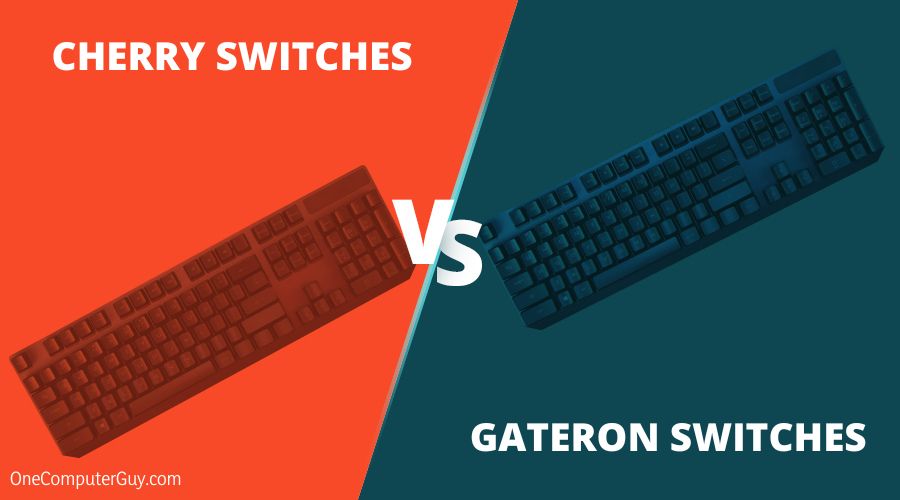Whether you’re a newbie to mechanical keyboards or a pro, you might be wondering about the difference between Cherry and Gateron switches. Cherry is the original and time-trusted brand, which some might prefer because of their name recognition and history. Gateron is a much younger brand but already has become well-regarded for its smoothness and more affordable cost.

Ultimately, choosing keyboard switches is a very personal decision based on what kind of feel, sound, and overall experience you prefer.
Some users prefer Gateron switches because of their smooth feel and cheaper price. However, some might be more comfortable with Cherry switches if they’re already been typing on them for years.
| Properties | Cherry Switches | Gateron Switches |
| Colors | MX Red, Silent Red, Brown, and Blue | Red, Brown, and Blue |
| Price | $0.50 to $1.00 per switch | $0.33 per switch |
| Keystrokes | 50 million per key | 50 million per key |
| Behaviors | Linear, Tactile, Clicky | Linear, Tactile, Clicky |
In this article, we’ll discuss the major differences between Cherry and Gateron, provide a list of everything to consider when looking for switches, and finally compare their most popular models (Red, Brown, and Blue) so you can figure out exactly which switches are best for you.
Contents
1. Cherry
Cherry is an American-founded company that traces back to 1953. The company moved to Germany in 1979, where it still operates today. Cherry has been in the business of making keyboards since 1973. They’re not only regarded as the oldest keyboard manufacturer around, but they’re also credited as being behind much of the mechanical keyboard industry.
Because of this impressive history, Cherry MX switches are regarded as the industry standard. Cherry held the patent and rights for their switch designs until recently, which made them the sole operator on the market. However, when the patent expired a few years ago, companies slowly started cropping up copying their designs.
Today, Cherry MX switches are still seen by some as the best simply because they were the first. They are very high quality and durable and are still seen as the go-to switch for many mechanical keyboards.
They generally sell for around $0.50 to $1.00 per switch, which is a bit pricier than their competitors. However, for those devoted to the Cherry brand, the extra cents are worth it.
All of the different kinds of Cherry switches are coded by color to mark their differences. Each switch type is simply referred to by its color and has its unique design, feel, and sound. Cherry switches tend to have around 50 million keystrokes per key; enough for a lifespan of decades.
Because Cherry was the original maker of switches and the sole holder of the patent for so long, all other companies can be considered copycats. However, this doesn’t mean that other companies are worse.
Most of the other upstart companies in the keyboard switch business have made changes to Cherry’s original patents. In fact, the reputation of these companies quickly went from copycats to fully-fledged competitors when users realized their switches were just as good as Cherry’s.
This is why some now prefer to use other brands than Cherry, in addition to the lower cost of these other brands.
2. Gateron
Gateron switches are made by electronic manufacturer Huizhou Gateron Electronic Technology Co., Ltd, a Chinese company founded in 2000. Gateron began by making more or fewer clones of Cherry MX switches.
However, in recent years they have branched out and some users have noted they’ve improved upon the Cherry switches. Gateron is most known for the smoothness of its switches, particularly in their linear switches. For many years now, Gateron switches have been well-regarded in the enthusiast community.
Gateron, like many other upstarts in the switch business, base their switches on the color-coded system developed by Cherry. This means that Cherry Red switches and Gateron Red switches are comparable, Cherry Brown and Gateron Brown switches are comparable, and so forth. Luckily, this makes it much easier to compare the products by both companies.
So how do Gateron switches really match up to Cherry switches? Gateron switches also have a 50 million keystroke limit, making their lifespan identical to Cherry switches. Their switches are also identical in other aspects, such as spring force, travel distance, and actuation point.
The main difference between the two as noticed by users is the superior smoothness of Gateron switches and their cheaper price. Compared to the usual $1 price of each Cherry switch, we found some Gateron switches selling for around $0.33 each. Prices may differ depending on where you purchase them from.
Therefore, if saving money is an incentive for you, Gateron may be the better choice. However, it’s still a good idea to try to test out the feel of the switches before investing in a set of keyboard switches.
What Should You Look For?
There are many different things to consider before buying switches for your mechanical keyboard. We’ll outline the main aspects that differentiate switches from each other.
These categories should hopefully help you pick out which switches are best for you depending on what you want from your mechanical keyboard.
– Actuation Type
Actuation type is the main consideration you should make when shopping for keyboard switches. There are three different kinds of key actuation: linear, tactile, and clicky.
Linear actuation gives you no feedback or bump when the switch is pressed. Instead, there is simply the feeling of smooth steady pressure until the switch hits the bottom. These switches are the quietest of the three, and some are designed to be silent.
Linear switches provide a smooth gaming experience especially if you’re using your keyboard to control your character’s movement. However, if you’re going to be using your keyboard to do any typing, it might be hard to get used to it because you won’t feel when it actuates (when the keystroke registers with the computer).
The types of linear switches are Red (the most common), Silent Red, Black, and Silver.
Tactile switches have a small bump when you press on the switch. This means you can feel when the switch is pressed and will feel it the moment that the key actuates. This makes tactile switches great for both gaming and typing.
Tactile switches aren’t as smooth as linear switches but are still used frequently by gamers who prefer feeling when the key actuates. Types of tactile switches include Brown (the most popular), Clear, and Gray.
The final type of switch is clicky switches. These feel identical to tactile switches but feature the clicky sound when they are pressed. These are the most divisive type of switches; some users love the crisp clicky sound whereas others hate it and find it annoying to listen to.
The clicky sound can be quite loud, so it’s not recommended if you’ll be using your keyboard in a coworking environment or shared spaces in your home. Likewise, it’s not a great choice if you’re a streamer because the clicks will sound pretty loud and will be distracting to your audience.
Clicky switches are stereotypically used for typing and data entry, but gamers also use them! It just all comes down to how you feel about the clicky sound. Switches of this type are Blue and Green.
– Travel Distance
Travel distance is basically how far your fingers travel downwards with each keystroke. The majority of switches have a travel distance of 4mm. This is the standard travel distance for key switches, but some “speed” switches have smaller travel distances.
The other distance to consider is the actuation distance. This is the distance your finger has to travel for the key to actuate. This usually hovers around the 2mm mark, but some have slightly higher actuation distances like 2.2mm and 2.3mm.
– Actuation Force
Actuation force varies across all types and refers to the amount of force needed to actuate the key (for the keystroke to register on the computer). Higher actuation force might mean that your fingers tire out faster. However, this could be a good option if you’re a bit heavy-handed or have large fingers. The heavier actuation force will offer plenty of resistance to prevent accidentally hitting any keys.
Lighter actuation force is preferable if you have smaller hands or you tend to type lightly. In this case, lighter actuation force will allow you to type more comfortably since heavier springs will tire your hands out and lead to fatigue.
Below we’ll compare the top three most popular kinds of switches from both brands: Red, Brown, and Blue. Red and Brown are typically the most commonly used for gaming keyboards, but some may prefer Blue if they’re a fan of the clicky sound. Let’s see how the two brands’ versions match up!
Cherry Red vs Gateron Red
Cherry reds are the quietest of the Cherry MX switches, however, you still can hear when the key hits the bottom of the keyboard. For those who want an absolute silent experience, Cherry also makes the Silent Red, which is engineered to make minimal noise when pressed.
Gateron reds are strikingly similar in feel and sound to the Cherry reds. They are smooth, light, and super responsive. Some users have noted that the Cherry reds are slightly more scratchy than the Gateron reds, although this is not very noticeable.
Which one is quieter? Gateron also makes a Silent Red to compete with the Cherry Silent Red. If you already have Cherry Red or Gateron Red switches and want to make them quieter yourself, you can lower the noise successfully by installing silicone o-rings to each switch.
– Specifications
-
Cherry MX Red:
Actuation Force – 45cN
Actuation Distance – 2.0mm
Travel Distance – 4.00mm
Feel – Linear -
Gateron Red:
Actuation Force – 45cN
Actuation Distance – 2.0mm
Total Travel – 4.00mm
Feel – Linear
Cherry Brown vs Gateron Brown
Brown switches are the other most common switch type used by gamers. If they don’t like the linear red switches, browns offer a nice in-between key switch that offers a bump feeling upon actuation but without the loud clicky sound of blues.
Gateron switches are of course noted for being smoother than the Cherry switches. This means that with the Cherry browns which are slightly stiffer, you will have to increase your force more as you type.
However, with that, Cherry offers a louder actuation, which makes it clearer and more obvious when you’ve actuated. In contrast, Gateron is lighter and softer, which makes the actuation less noticeable.
When deciding between the two, you will need to consider what level of force and what sound level you prefer. If you don’t want to be distracted by typing sounds, then it might be best to avoid the Cherry browns, which are louder because of the higher force you need to hit the keys with to actuate. Gateron offers a quieter and smoother experience, which many may prefer for gaming.
If you’ll be using your keyboard solely for gaming, then the Gateron browns will serve you better because of the increased smoothness. However, if you plan on using the keyboard for both gaming and typing, the Cherry browns may be a better choice.
– Specifications
-
Cherry Brown:
Actuation Force – 55cN
Actuation Distance – 2.0mm
Travel Distance – 4.0mm
Feel – Tactile -
Gateron Brown:
Actuation Force – 55cN
Actuation Distance – 2.00mm
Travel Distance – 4.00mm
Feel – Tactile
Cherry Blue vs Gateron Blue
Blues aren’t typically used by gamers on their mechanical keyboards, but some do enjoy the clicky noise even while gaming. Typically preferred by typists, the Cherry blue offers a crisp click upon each keystroke. If you get satisfaction from the click sound, then blues might be for you.
What are the differences between Cherry blues and Gateron blues? They are pretty similar overall, but the click of the Cherry blue is slightly softer than that of the Gateron blues, which are a bit sharper. However, the Cherry blues have a lower actuation force, meaning less pressure you’ll have to exert which may help prevent fatigue.
– Specifications
-
Cherry Blue:
Actuation Force – 50cN
Actuation Distance – 2.2mm
Travel Distance – 4.0mm
Feel – Clicky -
Gateron Blue:
Actuation Force – 55cN
Actuation Distance – 2.3mm
Travel Distance – 4.00mm
Feel – Clicky
Final Thoughts
Each person will have a preference between brands or types of switches. Both Cherry and Gateron rank as the ultimate top manufacturers that make durable and high-quality switches, so ultimately, it’s up to you which one feels and/or sounds better to you.
Ideally, you’ll want to try out both Cherry and Gateron switches before buying. Mechanical keyboards are all about creating your ideal keyboard setup based on how it feels to you, not which is rated objectively as “better”.
If you can make it to a store that has different mechanical keyboards to try out, we recommend going and trying them in person. If you don’t have a store nearby, you can also buy switch samplers from online for around $5 to $15 depending on how many keys they have.
While Gateron and Cherry switches are almost indistinguishable in some respects, Gateron is a great choice if you’re on a budget or if you want the ultimate smoothest linear switch.
If you prefer tactile or clicky switches and are willing to pay a bit more, Cherry might be better for you.







